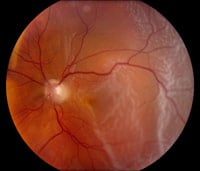Retinal Detachment
 Retinal detachments can occur at any time, at any age. Most of these detachments occur spontaneously, without any inciting event. Retinal detachments inevitably proceed to blindness without treatment. They can present without any symptoms, with flashes or floaters (See Flashes and Floaters) or with a dark shadow that starts in your peripheral vision and slowly advances to the center part of your vision. Retinal detachments need surgical repair by a retina specialist. The procedures include pneumatic retinopexy, vitrectomy, scleral buckle, or a combination.
Retinal detachments can occur at any time, at any age. Most of these detachments occur spontaneously, without any inciting event. Retinal detachments inevitably proceed to blindness without treatment. They can present without any symptoms, with flashes or floaters (See Flashes and Floaters) or with a dark shadow that starts in your peripheral vision and slowly advances to the center part of your vision. Retinal detachments need surgical repair by a retina specialist. The procedures include pneumatic retinopexy, vitrectomy, scleral buckle, or a combination.
A pneumatic retinopexy is performed in the office. A gas bubble is injected into the eye to flatten out your retina. Cryotherapy (freezing) treatment or laser treatment is also used to keep the retina attached. You may have to position your head in a certain position after the procedure.
A vitrectomy is performed in the operating room. The vitreous gel is removed and your retina is reattached. After the surgery, a gas bubble is left in your eye to push on the retina while it heals. You may have to position your head in a certain way (face down, on one side, etc.) for a week or so after surgery.
A scleral buckle is performed in the operating room. A silicone plastic band that acts like a belt is placed around the wall of the eye and tightened, to provide your retina some support. Then, Cryotherapy (freezing) treatment is used to keep the retina attached.
Your retinal specialist will determine which procedure is most appropriate for your retinal detachment.
